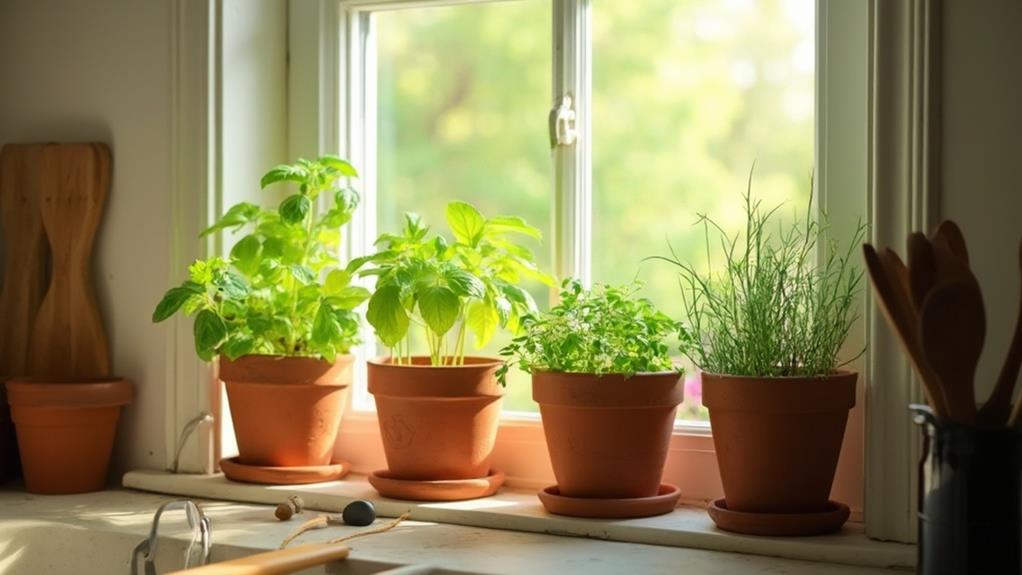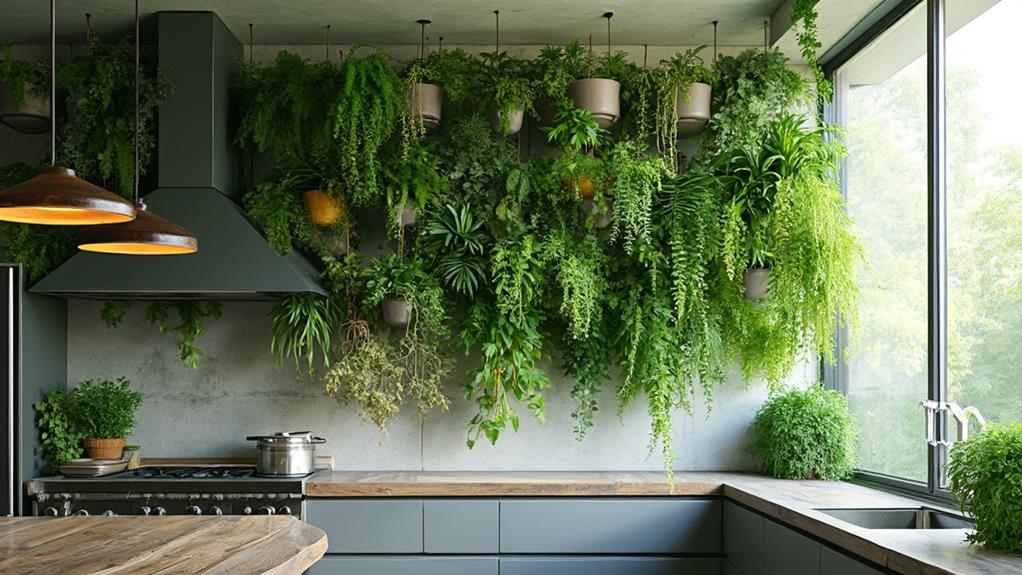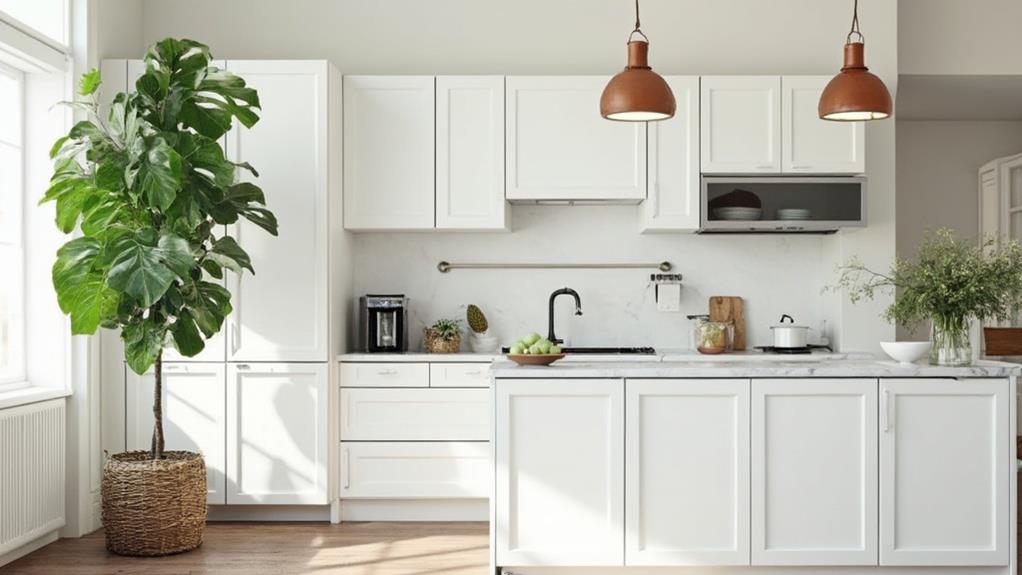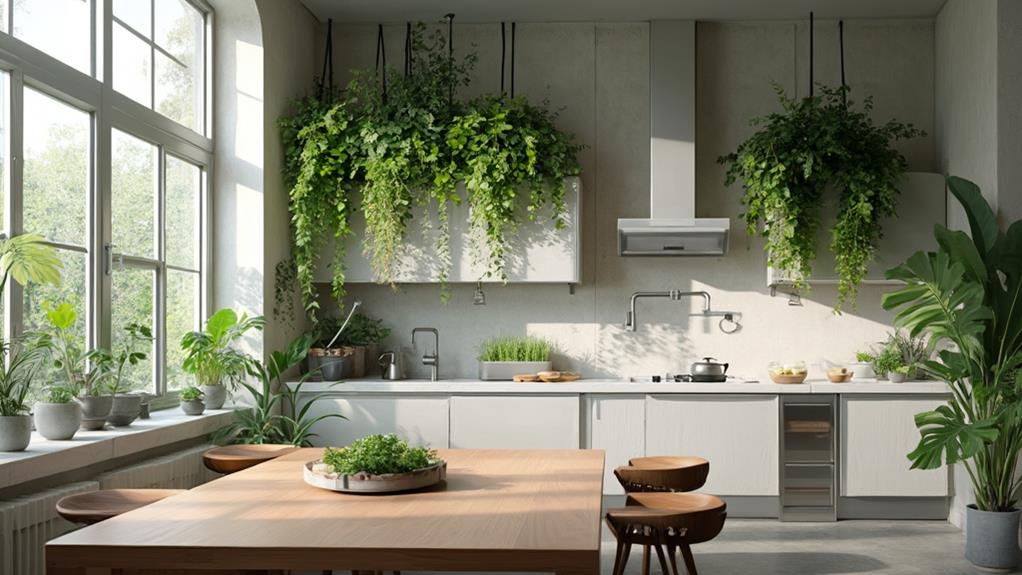To incorporate plants and greenery into your kitchen design, start with a windowsill herb garden for fresh cooking ingredients. Hang plants from the ceiling or walls to save counter space and add visual interest. Create a vertical green wall for a stunning focal point. Place stylish planter boxes on countertops for easy access to herbs and small plants. Add a statement potted tree for a bold, natural element. Choose plants that thrive in your kitchen's lighting conditions and complement your decor style. With proper care and maintenance, these green additions will transform your kitchen into a lush, inviting space. Discover more ways to bring nature indoors and elevate your culinary environment.
Windowsill Herb Gardens

If you're looking to add a touch of greenery to your kitchen, a windowsill herb garden is the perfect place to start. It's a practical and attractive way to bring nature indoors while providing fresh herbs for your cooking.
Choose a sunny windowsill that receives at least six hours of direct sunlight daily. Select herbs that thrive in indoor conditions, such as basil, chives, mint, oregano, and thyme. Use small pots with drainage holes and high-quality potting soil to ensure proper growth.
Arrange your herbs in an aesthetically pleasing manner, considering their heights and textures. You can use matching containers for a uniform look or mix and match for a more eclectic style. Don't forget to label each plant for easy identification.
Water your herbs regularly, but avoid overwatering. Most herbs prefer slightly dry soil between waterings. Fertilize monthly with a balanced, water-soluble fertilizer to keep them healthy and productive.
Harvest your herbs frequently to encourage bushier growth and prevent flowering. This will also ensure a constant supply of fresh herbs for your culinary creations. With proper care, your windowsill herb garden will become a beautiful and functional addition to your kitchen design.
Hanging Plant Displays
While windowsill herb gardens offer a practical solution for small spaces, hanging plant displays can transform your kitchen's vertical space into a lush, green oasis. These eye-catching installations not only add visual interest but also maximize your kitchen's plant-growing potential.
To create a stunning hanging display, start by selecting plants that thrive in indoor environments and don't require frequent watering. Spider plants, pothos, and string of pearls are excellent choices. Next, choose hanging planters that complement your kitchen's style. Options range from sleek metal containers to rustic macramé holders.
Consider the placement of your hanging plants carefully. Install sturdy hooks or brackets in the ceiling or walls, ensuring they can support the weight of your plants. Group plants of varying lengths and textures for a dynamic look, or create a uniform display with matching planters.
Don't forget to factor in lighting when positioning your hanging plants. Place sun-loving varieties near windows, while shade-tolerant plants can thrive in dimmer areas. With proper care and placement, your hanging plant display will become a captivating focal point in your kitchen, bringing nature indoors and elevating your space's overall ambiance.
Vertical Green Walls

Creating a vertical green wall in your kitchen can transform an ordinary space into a breathtaking living artwork. These lush, plant-covered structures add depth, texture, and natural beauty to your culinary environment.
To start, choose a suitable wall that receives adequate light. Install a sturdy frame system designed for vertical gardens, ensuring proper support for the plants and irrigation.
Select a variety of plants that thrive in your kitchen's conditions. Mix different textures, colors, and sizes for visual interest. Consider herbs like basil, mint, and thyme for both aesthetics and culinary use. Ferns, pothos, and philodendrons work well for their cascading effect. Use drought-resistant succulents in areas with less moisture.
Implement a reliable irrigation system to maintain your green wall. Drip irrigation or self-watering planters can simplify maintenance. Don't forget to include proper drainage to prevent water damage to your kitchen walls.
Maintain your vertical garden by regularly pruning, fertilizing, and replacing plants as needed. With proper care, your kitchen's green wall will continue to flourish, purifying the air and creating a unique, nature-inspired focal point in your cooking space.
Countertop Planter Boxes
Countertop planter boxes offer a practical and attractive way to bring greenery into your kitchen without sacrificing valuable workspace. These versatile containers come in various sizes and materials, allowing you to customize your kitchen's green touch. Opt for sleek, modern designs in stainless steel or ceramic to complement contemporary kitchens, or choose rustic wooden boxes for a farmhouse-style charm.
Select herbs and small plants that thrive in indoor conditions and are useful for cooking. Basil, mint, chives, and parsley are excellent choices that'll add both visual appeal and fresh flavors to your culinary creations. Succulents and air plants can also work well in kitchens with limited natural light.
Place your planter boxes strategically on countertops near windows or under cabinet lighting to ensure adequate sunlight. Consider using self-watering planters to minimize maintenance and prevent water damage to your surfaces. You can also create a tiered display using different-sized boxes to maximize vertical space and create visual interest.
Remember to use saucers or waterproof mats beneath your planter boxes to protect your countertops from moisture. With proper care and placement, countertop planter boxes will enhance your kitchen's aesthetic while providing easy access to fresh herbs and greenery.
Statement Potted Trees

For those seeking a bold and dramatic green accent in their kitchen, statement potted trees can transform the space into a lush oasis. Choose species that thrive indoors and suit your kitchen's light conditions. Fig trees, olive trees, and citrus trees are popular options that add height and visual interest.
Consider the tree's mature size when selecting a spot. A corner near a window is ideal, providing ample light and creating a focal point. Ensure your tree has enough room to grow without obstructing traffic flow or work areas. Choose a sturdy, stylish pot that complements your kitchen's design and provides adequate drainage.
Maintain your statement tree by watering it regularly, dusting its leaves, and pruning as needed. You may need to supplement natural light with grow lights during darker months. Rotate the tree occasionally to promote even growth and prevent it from leaning towards light sources.
A statement potted tree can soften hard kitchen surfaces, improve air quality, and create a connection with nature. It's an investment in your kitchen's atmosphere, so select a tree you'll enjoy caring for long-term.
Edible Indoor Gardens
Many kitchens can benefit from an edible indoor garden, combining functionality with natural beauty. You'll enjoy fresh herbs and vegetables year-round while adding a vibrant touch to your space. Start by selecting a sunny spot near a window or install grow lights for optimal plant health. Choose containers with proper drainage and fill them with high-quality potting soil.
Popular herbs for indoor gardens include basil, mint, thyme, and rosemary. These aromatic plants not only enhance your cooking but also fill the air with pleasant scents. For vegetables, consider compact varieties like cherry tomatoes, microgreens, or dwarf peppers. Lettuce and spinach are also excellent choices for indoor cultivation.
To maximize space, use vertical gardening techniques such as wall-mounted planters or tiered shelving units. Hanging baskets can be suspended from the ceiling or mounted on walls to create a cascading effect. Don't forget to incorporate a watering system, like self-watering containers or a drip irrigation setup, to simplify maintenance. With proper care and attention, your edible indoor garden will thrive, providing fresh ingredients and a lively atmosphere in your kitchen.
Conclusion
As you're chopping vegetables for dinner, you glance up and notice how the sunlight dances through your new kitchen greenery. It's no coincidence that your mood has lifted since bringing nature indoors. You've transformed your kitchen into a lush oasis, from the herbs on your windowsill to the statement fiddle-leaf fig in the corner. Embrace this green revolution, and you'll find your culinary space isn't just functional—it's a living, breathing part of your home.

